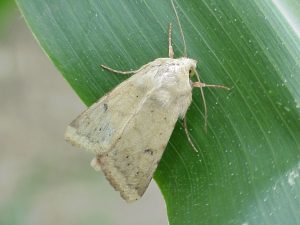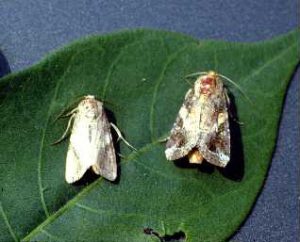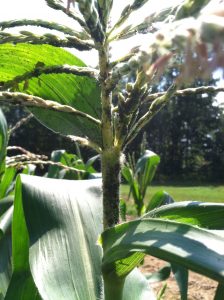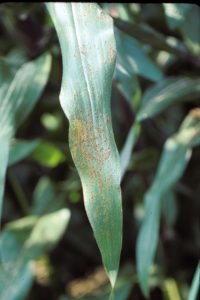Sweet Corn IPM Newsletter No. 10 – August 25, 2017
Sweet Corn IPM Newsletter No. 10 – August 25, 2017
Click on photos to enlarge.
INSECT NUMBERS RISE, INCREASING THREAT
Corn Earworm, Fall Armyworm, European Corn Borer Moth Counts Higher
SITUATION
Fine weather has kept corn development at a good pace, and supply is improving. Quality has been very good in fields where growers have been able to irrigate. Pests that normally emerge later in the season, such as rust and aphids are starting to show up in many fields.
European corn borer: Moth counts continue to be spotty, with many locations having no moths, but two having counts over the threshold for silking corn. Fields in Wayne and Poland Spring were over the 5-moth threshold for silking corn. Larval feeding injury was still low, but more small larvae are starting to show up in pre-tassel corn.
Corn earworm: Moth counts were generally higher in most locations this week, calling for a tighter spray schedule for silking corn in most fields, although a few locations had no moths, including Monmouth, Farmington, Oxford, Levant and Palmyra. A 6-day spray interval for corn earworm was recommended for silking fields in Wales and Garland. A 5-day spray schedule was recommended in Bowdoinham, Charleston, Lewiston and one Wells site. A 4-day spray interval was recommended in Auburn, Biddeford, Cape Elizabeth, one Dayton site, Nobleboro, North Berwick, and one Wells site.
- Corn Earworm Moth; photo by David Handley
- Fall Armyworm Moths (female right, male left); photo by James Dill
Fall armyworm: Similar to corn earworm, moth counts were mostly higher this week, with many sites over the 3-moth threshold for silking corn. A spray for fall armyworm on silking corn was recommended at one site in Dayton, Monmouth, New Gloucester, Oxford and Sabattus. Other sites, including Auburn, Biddeford, Cape Elizabeth, Lewiston, Nobleboro, and Wells were also over the 3-moth threshold, but are on a spray schedule for corn earworm. Larval feeding damage in younger corn was lower this week. Fields in Biddeford, and Wells were over the 15% injury threshold, and sprays for pre-tassel to tassel corn were recommended.
Corn leaf aphids have been observed in many fields this week. Colonies of these small, bluish-green insects can cover the tassels, stalks and husks. The aphids excrete a “honeydew” on the leaves and husks, which stimulates the development of sooty mold fungus. This dark, slimy coating greatly reduces the visual appeal of the ears. Sprays applied for corn earworm usually control aphids.
- Aphids on Corn; photo by Kaytlin Woodman
- Rust on Corn; photo by David Handley
Corn rust: We have also seen corn rust in many fields this week. Rust is a fungus disease that causes reddish-brown pustules to form on the leaves and husks, reducing the quality of the ears. Typically, corn rust does not become a problem until late in the season. A fungicide spray for rust would only be recommended if the infection were noticed in a field prior to tasseling. Later infections are unlikely to cause enough damage to the crop to justify control measures. Materials available to control corn rust include Quadris®, Bravo®, and Quilt®.
Spotted wing drosophila: Numbers continue to increase in fields with ripe berry fruit. Regular sprays (every 5-7 days) will be needed to prevent raspberries, blueberries and day neutral strawberries from becoming infested with larvae. Visit our Spotted Wing Drosophila blog for more information.
Sincerely,
David T. Handley
Vegetable and Small Fruit Specialist
Highmoor Farm, P.O. Box 179, 52 US Route 202, Monmouth, ME 04259, 207.933.2100
UMaine Extension Diagnostic Research Lab, Pest Management Unit, 17 Godfrey Drive, Orono, ME 04473, 1.800.287.0279
| Location | CEW Moths |
ECB Moths |
FAW Moths |
%Feeding Damage |
Recommendations / Comments |
|---|---|---|---|---|---|
| Auburn | 18 | 0 | 21 | 4-day spray interval recommended on all silking corn | |
| Biddeford | 13 | 1 | 22 | 24% | 4-day spray interval recommended on all silking corn |
| Bowdoinham | 6 | 0 | 2 | 5-day spray interval recommended on all silking corn | |
| Cape Elizabeth I | 28 | 2 | 19 | 6% | 4-day spray interval recommended on all silking corn |
| Cape Elizabeth II | 20 | 3 | 11 | 14% | 4-day spray interval recommended on all silking corn |
| Charleston | 4 | 0 | 2 | 5-day spray interval recommended on all silking corn | |
| Dayton I | 1 | 0 | 4 | One spray on silking corn for FAW | |
| Dayton II | 19 | 0 | 12 | 8% | 4-day spray interval recommended on all silking corn |
| Farmington | 0 | 4 | 0 | No spray recommended | |
| Lewiston | 6 | 0 | 9 | 5-day spray interval recommended on all silking corn | |
| Garland | 2 | 0 | 0 | 1% | 6-day spray interval recommended on all silking corn |
| Levant | 0 | 0 | 0 | 2% | No spray recommended |
| Monmouth | 0 | 0 | 5 | 1% | One spray on silking corn for FAW |
| New Gloucester | 0 | 67 | 5% | One spray on silking corn for FAW | |
| Nobleboro | 8 | 0 | 9 | 4-day spray interval recommended on all silking corn | |
| North Berwick | 32 | 0 | 9 | 0% | 4-day spray interval recommended on all silking corn |
| Oxford | 0 | 0 | 5 | 3% | One spray on silking corn for FAW |
| Palmyra | 0 | 0 | 0 | 0% | No spray recommended |
| Poland Spring | 6 | One spray on silking corn for ECB | |||
| Sabattus | 1 | 1 | 3 | One spray on silking corn for FAW | |
| Wales | 2 | 0 | 2 | 2% | 6-day spray interval recommended on all silking corn |
| Wayne | 1 | 5 | 0 | One spray on silking corn for ECB | |
| Wells I | 9 | 0 | 3 | 17% | 4-day spray interval recommended on all silking corn |
| Wells II | 6 | 4 | 24 | 8% | 5-day spray interval recommended on all silking corn |
CEW: Corn earworm (Only fresh silking corn should be sprayed for this insect.)
ECB: European corn borer
FAW: Fall armyworm
| Moths caught per week | Moths caught per night | Spray interval |
|---|---|---|
| 0.0 to 1.4 | 0.0 to 0.2 | No spray |
| 1.5 to 3.5 | 0.3 to 0.5 | Spray every 6 days |
| 3.6 to 7.0 | 0.6 to 1.0 | Spray every 5 days |
| 7.1 to 91 | 1.1 to 13.0 | Spray every 4 days |
| More than 91 | More than 13 | Spray every 3 days |
Thresholds apply only to corn with exposed fresh silk. Lengthen spray intervals by one day if maximum daily temperature is less than 80°F.
European Corn Borer Thresholds
Whorl stage: 30% or more of plants scouted show injury.
Pre-tassel-silk: 15% or more of plants scouted show injury.
Silk: 5 or more moths caught in pheromone traps in one week.
IPM Web Pages:
UMaine Cooperative Extension Integrated Pest Management
Penn State Pest Watch for Sweet Corn
UMass Amherst Integrated Pest Management
Where brand names or company names are used, it is for the reader’s information. No endorsement is implied nor is any discrimination intended against other products with similar ingredients. Always consult product labels for rates, application instructions and safety precautions. Users of these products assume all associated risks.
The University of Maine is an equal opportunity/affirmative action institution.




